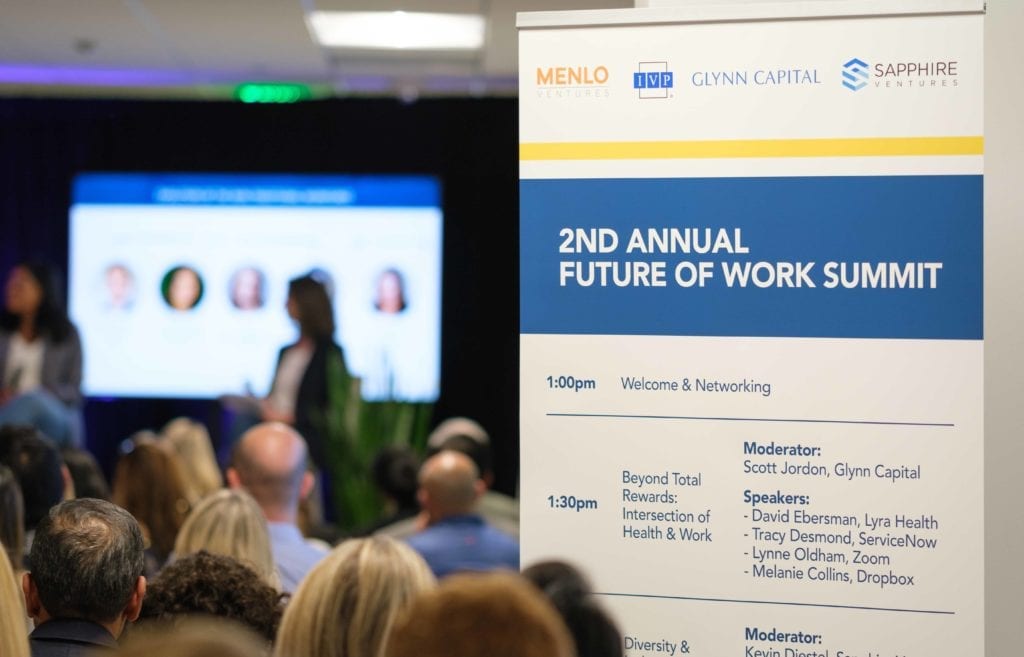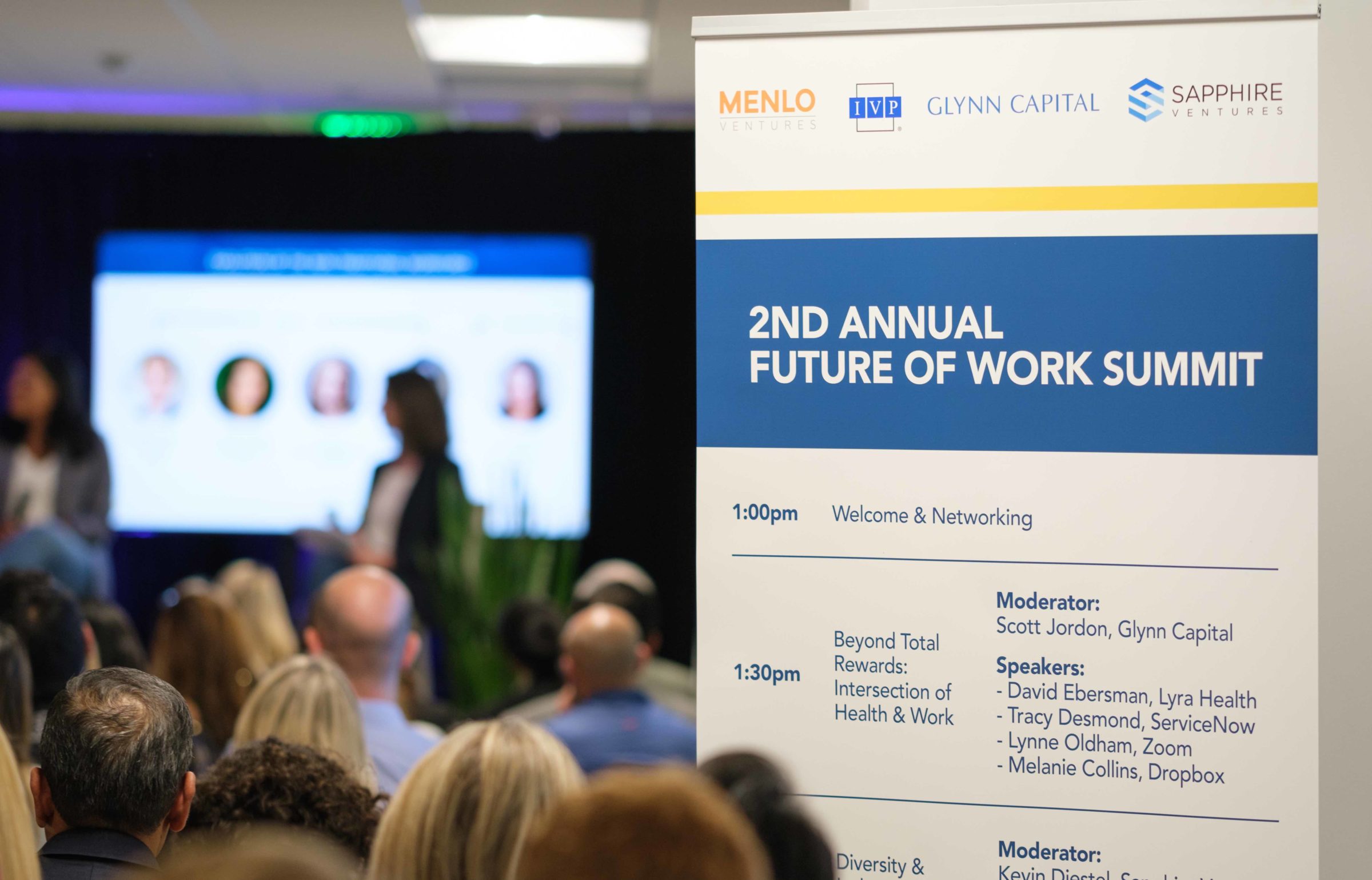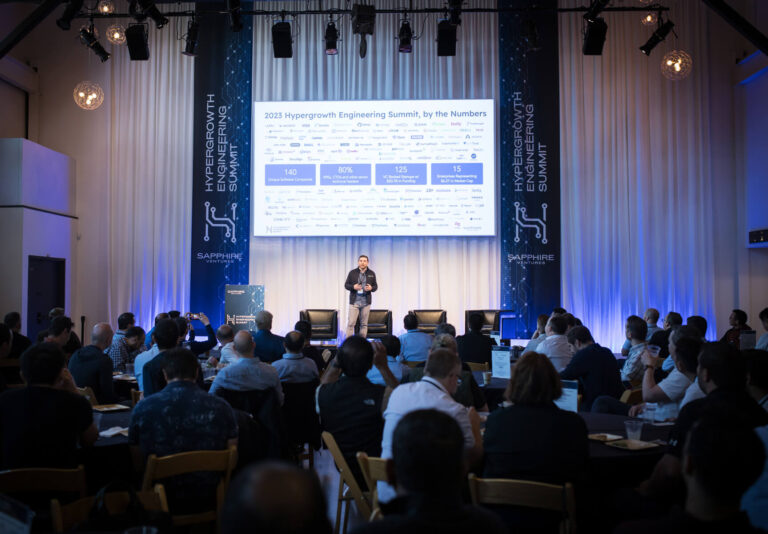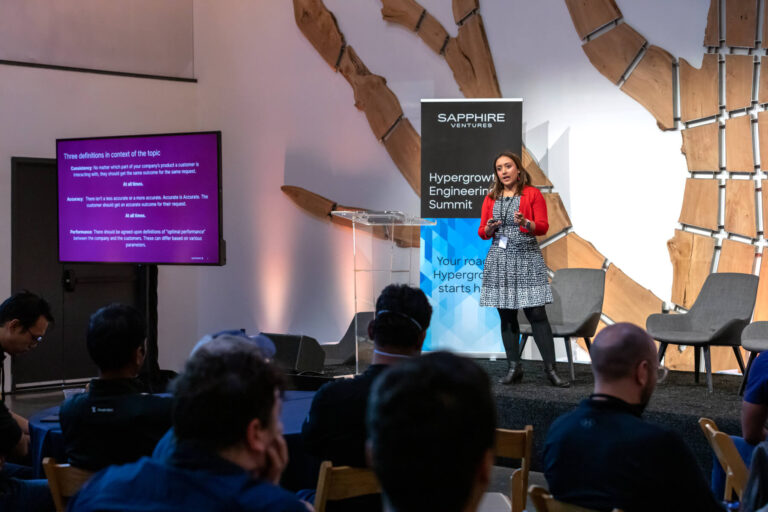After an incredible afternoon of learning from HR and Talent leaders in the tech ecosystem, the teams from Glynn Capital, IVP, Menlo Ventures, and Sapphire Ventures summarized the takeaways from our Future of Work Summit to help continue the conversation about how we can best support and empower employees now–and in the future.

The way we work today looks very different from how we’ve worked in the past. We’re no longer working “9-to-5” or delineating between in or out of the office. Today’s workers are “always-on” and “available anywhere.” They work better, faster, more efficiently, and in a more distributed way. Advancements in technology have extended the boundaries of where we work and how work gets done. It’s up to HR leaders to help meet employees where they are and to support them in doing their best work.
The future of work will be all about people. That’s why Glynn Capital, IVP, Menlo Ventures, and Sapphire Ventures recently hosted a Future of Work Summit. We invited dozens of experts–including CEOs, HR, and People Leaders from technology startups and public companies–for a conversation about how we think about and engage in work across the startup ecosystem.
Here are some of the key themes explored at our second annual Future of Work Summit:
1. Benefits Need to Adapt to the Modern Workforce
Perhaps the most commonly cited challenge for HR leaders is building benefits packages that extend beyond standard benefits (health, dental, vision). With the line between work and personal life now increasingly blurry, companies who design new, nontraditional benefits can differentiate themselves.
Panelists emphasized that benefit leaders should consider including tuition and debt consolidation benefits, flexible work policies, and family and dependent care options to better serve the needs of their employees. Each program should be evaluated within the context of usage and productivity, so that every dollar spent enables a more fulfilled and supported employee base.
Participants shared ideas on adding new benefits without blowing up the budget. These included mental health and therapy options provided by companies like Lyra Health and others. Some companies focused on physical fitness, providing stipends to cover gym memberships or massages through platforms like Gympass. Others mentioned solutions focused on financial health. SoFi can help employees consolidate student loan debt, while others specialize in investing. Additionally, some employers have expanded beyond the traditional “relocation bonus” to offer services to help employees find housing, which is particularly challenging in costly housing markets like San Francisco.
2. Creating Community Across a Distributed Workforce is Critical for Retention and Promotion
Our summit participants reported that 30% – 60% of their employees work from home or across distributed offices. It can be challenging to manage a diversity of working styles and needs outside of the traditional office walls.
In today’s global, connected workforce, companies must understand and support cultural differences across geographies. And sometimes, unique opportunities for connection will arise: one company realized that weekly code reviews provided an opportunity for international employees to practice their English and build relationships with peers across offices.
To create a culture of inclusion, employees must feel connected to an organization. This can be particularly challenging for organizations with remote workers in different countries. Summit attendees agreed that bringing remote employees to headquarters for an extended onboarding process or Quarterly Business Reviews can build lasting community and connections between remote and HQ-based colleagues. Another suggestion was to carry forward traditions that everyone can enjoy regardless of where their desks reside. Having shared traditions can make it easier to spark conversations and build connections. One company encouraged each employee to use a personal coffee/tea mug for work as a way to help break the ice, build culture, and also create a unique talking point.
3. Diversity and Inclusion Efforts Must Have a Dedicated Leader

According to a report by Weber Shandwick, 27% of Chief Diversity Officers said they face a challenge making the business case for diversity and inclusion. The good news is that the majority of top leaders do understand how critical these efforts are –but many are still figuring out the best approach.
Participants agreed that leaving inclusion as a to-do item is not enough. What does work is having a dedicated team member that is focused on driving inclusion across the organization. Ideally, the CEO and Chief Diversity Officer are one in the same, or in larger organizations very closely aligned. Additionally, companies can improve the effectiveness of their efforts by engaging employees early to get buy-in and participation from day one.
Data can also inform decisions and help companies create conditions to attract talented workers and help them thrive in their new jobs. Platforms like Eightfold.ai leverage artificial intelligence and candidate masking to identify candidates that are most likely to be successful at an organization and then help employers define career paths for them once they are hired to drive motivation and retention.
4. Becoming a More Compassionate Company Takes Care
More than 1 in 5 Americans suffer annually from a mental health condition such as anxiety or depression, according to a 2016 study by SAMHSA. More companies are seeking to improve their mental health benefits for employees, but these resources can be underutilized if a company’s culture isn’t obviously aligned or if mental health is a taboo topic. Our panelists suggested that having a champion at the company creates better conversations around mental health. They also recommended implementing programs to reduce the friction in finding care providers and treatment.
Addressing mental health is a meaningful way to increase productivity and overall retention; however, discussing mental health can be seen by some as a difficult conversation due to stigma and cultural differences. NAMI has reported that 8 in 10 employees don’t seek treatment for mental health conditions because of fear and shame. Recognizing that leaders aren’t often equipped with the resources to effectively support employees facing mental health conditions, organizations like Mind Share Partners work with employers to help them normalize mental health challenges, debunk myths, and navigate conversations between managers and their employees to build stronger, more human, workplaces.
Looking Ahead
There is no doubt that business leaders feel a certain amount of unease as they grapple with new challenges in our digital era, especially as they marshal and mobilize their workforces. Chief among concerns is keeping pace with the evolutions and shifts across the global workplace while helping each employee navigate their own path. By continuing to partner with creative people, talent, and technology leaders who are committed to pushing the frontiers of how we engage with work, we hope that we will all benefit from a more empowered, fulfilled, and productive workforce.



